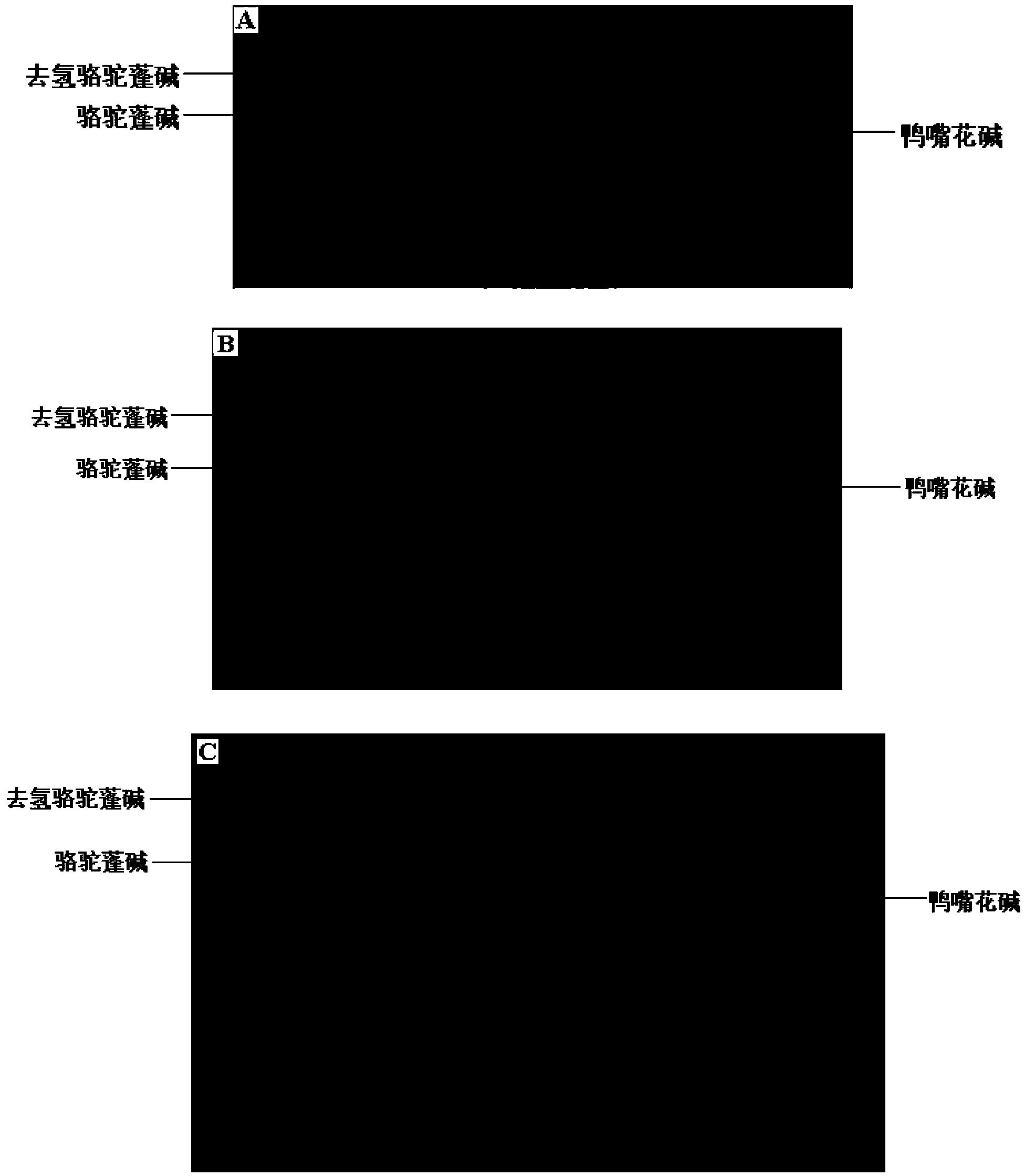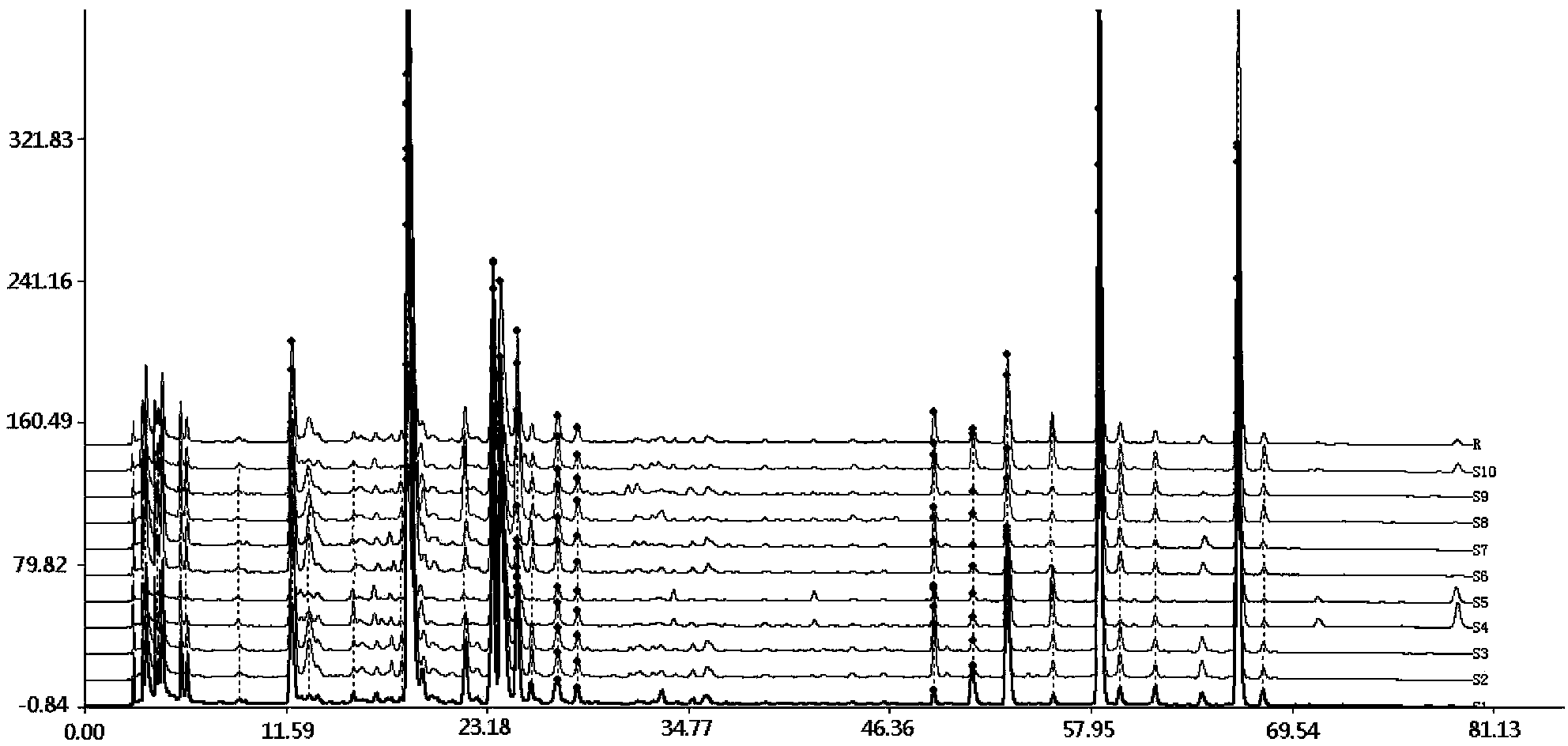Method for analyzing active component in harmel grass
A technology of camel grass and active ingredients, which is applied in the analysis of materials, material separation, measuring devices, etc., can solve the problems that cannot fully reflect the quality level of camel grass, achieve excellent reproducibility and specificity, good stability, Simple operation effect
- Summary
- Abstract
- Description
- Claims
- Application Information
AI Technical Summary
Problems solved by technology
Method used
Image
Examples
Embodiment 1
[0050] Embodiment 1: Construction of TLC fingerprint
[0051] a) Preparation of the test solution
[0052] Take 1g of camel grass powder, add 10mL of methanol, ultrasonically treat at 160~250W, 40kHz frequency for 30min, cool, filter with 0.45μm nylon microporous membrane, evaporate the filtrate, add 2mL of methanol to dissolve the residue, take the supernatant, That is the test solution.
[0053] b) Preparation of reference substance solution
[0054] Take 1 mg of each of dehydrohaeline, harmine and orchidine reference substances, and prepare solutions with 1 mL of methanol respectively, which is the reference substance solution;
[0055] c) Take 5 μL each of the above-mentioned test solution and reference solution, and spot them on fluorescent silica gel high-efficiency thin-layer plates respectively, with a mixed solvent formed by ethyl acetate-methanol-ammonia in a volume ratio of 10:1.5:0.5. Developing agent, developed, taken out, after drying, inspected under 254nm ul...
Embodiment 2
[0061] Embodiment 2: construct HPLC fingerprint atlas
[0062] a) Preparation of the test solution
[0063] Take 0.5g of camel grass powder, add 10mL of 70% methanol aqueous solution by volume, ultrasonically treat it at 160~250W, 40kHz frequency for 30 minutes, take it out, place it at room temperature, and make up the lost weight with 70% methanol, Shake well, and filter with 0.45 μm nylon microporous membrane, which is the test solution;
[0064] b) Preparation of reference substance solution
[0065] Accurately weigh the appropriate amount of orchidine, salicine, dehydrohaeline, deacetylated salicin and salicin, accurately weighed, and add methanol to prepare 80 μg of orthine and salicine per 1 mL The solution of 20 μg, 20 μg of dehydrohaevalline, 50 μg of deacetylated camelvalin and 50 μg of camelvalin is the reference solution;
[0066] c) Precisely draw 10 μL each of the test solution and the reference solution, and inject them into the high-performance liquid chroma...
Embodiment 3
[0081] Embodiment 3: to the assay of active ingredient
[0082] a) Preparation of the test solution
[0083] Take 0.5g of camel grass powder, add 10mL of 70% methanol aqueous solution by volume, ultrasonically treat it at 160~250W, 40kHz frequency for 30 minutes, take it out, place it at room temperature, and make up the lost weight with 70% methanol, Shake well, and filter with 0.45 μm nylon microporous membrane, which is the test solution;
[0084] b) Precisely draw 10 μL of the test solution, inject it into a high-performance liquid chromatograph for determination, and the high-performance liquid chromatographic conditions are as follows: the chromatographic column is a Boston Symmetrix ODS-AQ column (4.6mm×250mm), the mobile phase A is acetonitrile, and the mobile phase B is a 0.1% aqueous trifluoroacetic acid solution by volume, and the elution gradient is as follows:
[0085]From 0 to 5 minutes, the volume of mobile phase A is 5%, and the volume of mobile phase B is 95...
PUM
 Login to View More
Login to View More Abstract
Description
Claims
Application Information
 Login to View More
Login to View More - R&D
- Intellectual Property
- Life Sciences
- Materials
- Tech Scout
- Unparalleled Data Quality
- Higher Quality Content
- 60% Fewer Hallucinations
Browse by: Latest US Patents, China's latest patents, Technical Efficacy Thesaurus, Application Domain, Technology Topic, Popular Technical Reports.
© 2025 PatSnap. All rights reserved.Legal|Privacy policy|Modern Slavery Act Transparency Statement|Sitemap|About US| Contact US: help@patsnap.com



